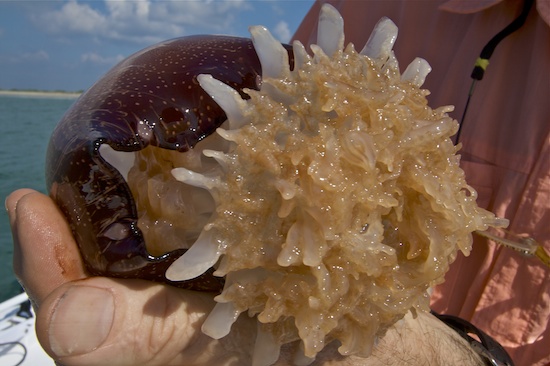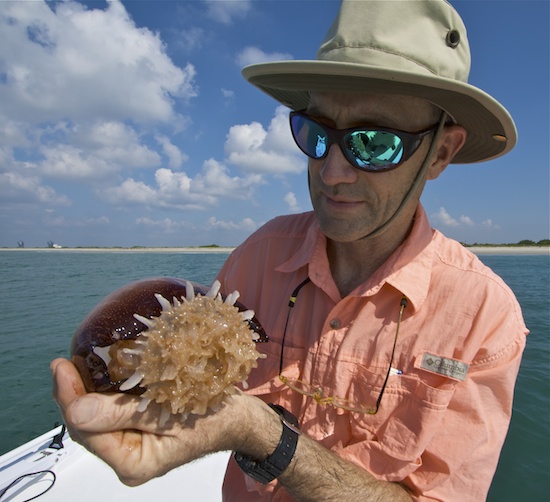Eating Cannonball Jellyfish from Mosquito Lagoon
A Guest Blog by Dave Caprera
OK, last time I collected 30-40 fiddler crabs and made a bisque. The picture of the crabs in the pot caught some of you unaware*. Well, I have upped the ante and gone one better. The cannonball jellyfish, Stomolophus meleagris, are now in large numbers in the lagoon.
Two days ago I collected four specimens and started reading. (I actually collected eight and threw four back.) There are about a dozen species of jellies that are eaten, almost entirely by Asians. One is the cannonball. (Its name is well deserved, it is round, about 8 inches in diameter, and weighs around 1 pound. Ready! Load! Fire!)
You can buy them dried and salted. They are salted because they do not keep fresh for very long. But there is little literature on preparing fresh jellyfish. The following is my recipe for their preparation.
1. Catch jellyfish. The cannonballs are among the strongest of the swimmers. Don’t worry, you are up to the task. They do not sting per se, but their mucous is found to be irritable to some. Didn’t bother me.
2. Rip the cap off. No one told me how to clean them. At first, I cut them carefully. Then I figured it out. Think of them as a mushroom. Separate the cap from the stem. Throw the stem away.
3. Scrape off the scum. Ah, this is the yucky part. They are slimy. Using a knife edge, scrape away.
4. Brine for 24 hours in the fridge in a salt water solution. Rinse. Brine again. Rinse. Rinse again (you are getting rid of the salt.). The brine cures them and assists in the slime removal. Scrape again.
5. At this point you should have firm, clean jellyfish filets. Drain. Now cover with boiling water for 15 minutes. Magic! They shrink in half. They also soften up. Rinse immediately in cold water. Now you can slice in 1/4 inch lengths.
6. There are two “common” recipes. Both served cold. The Chinese use soy sauce, rice wine vinegar, sesame oil and sugar. Toss and sprinkle with toasted sesame seeds. The Vietnamese use “fish sauce”, vinegar, oil, red pepper flakes and sugar. They toss with cucumbers, cilantro and shredded carrots. Variations are numerous. Both are good.
7. Eat. I am not kidding. This is good shit, almost zero carbs, high protein, low calorie.
Tune in next time for my dog whelk scungilli.
*This was not posted on this blog, unfortunately.
Dave Caprera, a retired attorney, now makes his home in New Smyrna Beach.
All content in this blog, including writing and photos, copyright John Kumiski 2013. All rights are reserved.
|Related articles


Back when I was a kid fishing from the Atlantic Beach pier, we used to retrieved the crabs that populate the underside of the cap for bait. Sometimes from above you can see their migration, seems like hundreds floating in sight of hte surface.
wish I had seen this before I went on vacation, panama city florida is swarming with these…
Stem is actually the more expensive part of the dish, in China anyway.
I grew up eating them, and many restaurants will serve the cap while advertising it as the stem. And charge you more of course.
Great article but…or you can just go to your favourite Chinese seafood restaurant. Yes tasty delicacy not often eaten by westerners.